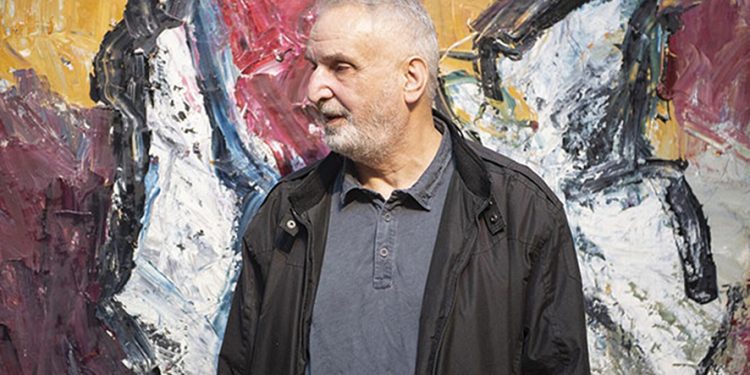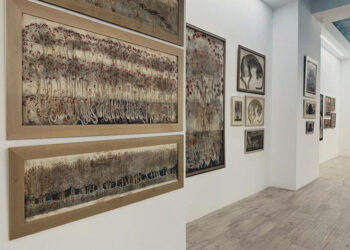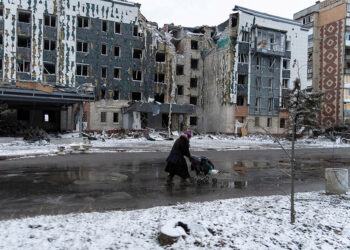Georgian Artist Ushangi (Khuma) Khumarashvili’s exhibition depicts the meeting point of chaos and order in society, while also giving a glimpse into his biography, artistic style, and transformations. Closing on November 16 at the Georgian Museum of Fine Arts, ‘Chaotic Order’ is the first exhibition which has shown Khumarashvili’s work since he passed away in 2023.
Khumarashvili was born in 1948 in the town of Dedoplistskaro, Kakheti. From 1967 to 1973, he studied at Tbilisi State Academy of Arts in the faculty of fine arts. Once he completed his education, he started working at the Telavi Drama Theater. According to his portfolio, it wasn’t until 1994 that he had his first solo exhibition at the Georgian National Gallery, showcasing his work. Prior to that, he participated in various group collaborations and large international art exhibitions.
Known as one of the founders of the modern art scene in Georgia, Khumarashvili’s work was not influenced by the Soviet Union. What was popular during the 1930s to the end of Soviet times was ‘Soviet Realism,’ a style that was intended to glorify Russian life and depict everyone as happy in the USSR.
This concept applied to everything considered art: literature, music, sculptures, and more. In Georgia, there were two waves of abstract art within the country: the first came in the 1950s-60s, then again in the 1980s-90s.
“Both waves, and their adherent artists, employed abstraction as a form of protest against Soviet rule. In the case of Ushangi, however, it was a natural expression and an artistic imprint of his way of thinking and lifestyle,” reads the exhibition’s description. “The artist is beyond conformist or nonconformist art. His artistic thirst is an archeology of creating one’s own self or something else.”
The ‘Chaotic Order’ exhibition is comprised primarily of Khumarashvili’s oil paintings: 19 paintings, all differing in color and size. Some are paired with Khumarashvili’s quotes, further playing on how his ‘chaotic words’ march at the order of his paintings.
The works on display were collected over several decades, spanning from the 1980s to 2023. While Khumarashvili’s primary medium was oil paint, he also explored other forms of expression, including graphic art, performance, video, and collage. Among the small collection of collages are at least 10 pieces made with a combination of paint, paper, and drawing materials. These collages feature a range of subjects, from depictions of people to more surprising themes, such as an image that seemed to reference the crucifixion of Christ, and another illustrating Germany’s street food, döner.
Despite his frequent use of oils, no two pieces in the exhibit are alike. Each artwork stands out with its own powerful color scheme, offering a unique expression and inviting viewers to uncover its hidden meanings.

Excerpts from Khumarashvili’s personal diary are also on display at the exhibition. These writings, like his visual art, are abstract and fragmented, documenting his observations and reflections on everyday life. Though the meaning is not immediately clear, the writing conveys a sense of depth and complexity, much like his paintings.
Khumarashvili’s Quotes
“There is the Centaurus silhouette in my being. The thrown space in abandoned windows. The bed is terrifying me. Wind is in windows. I find night sheds. Telavi is dark all along the way.” – July 18, 2000.
“Ugly years. I am turning fifty. I will have to live in terrible Tbilisi.” – February 14, 1998.
“I have become the subject of an aping ridicule.” – September 5, 1998.
“At least this heavy-hearted art won’t pass in vain… I get out. Get in. Start the engine. Cigarettes in the Harry Krishna in silence. There’s a descent. I do not think about anything. The feeling of inability is torture.” – December 22, 2017.
“There is a serious order in my thoughts. Desperate existence is logical. The herd-like existence of animals excludes order. Idleness is my existence.” – July 22, 2018.
A translation from the diary
“Morning, wine leaves are being shaken from the wind and with the silhouettes of the trees. You can hear the birds singing. The sky is quiet, the atmosphere has no color, and the warm day is close. It’s giving me a death sentence. Loneliness is not sparing me… There in the street is a broken police car. They put them on the ground and are tying their hands. She’s looking at me with those eyes. Bibi is close, scratching at me with her paws and looking at me with her hands.”
Together, the works in the exhibition, both visual and written, create a fascinating interplay of order and chaos, with each piece enhancing the understanding of the other, and showing Georgian society, past and present, interestingly through Ushangi Khumarashvili’s unique perspective.
By Shelbi R. Ankiewicz














